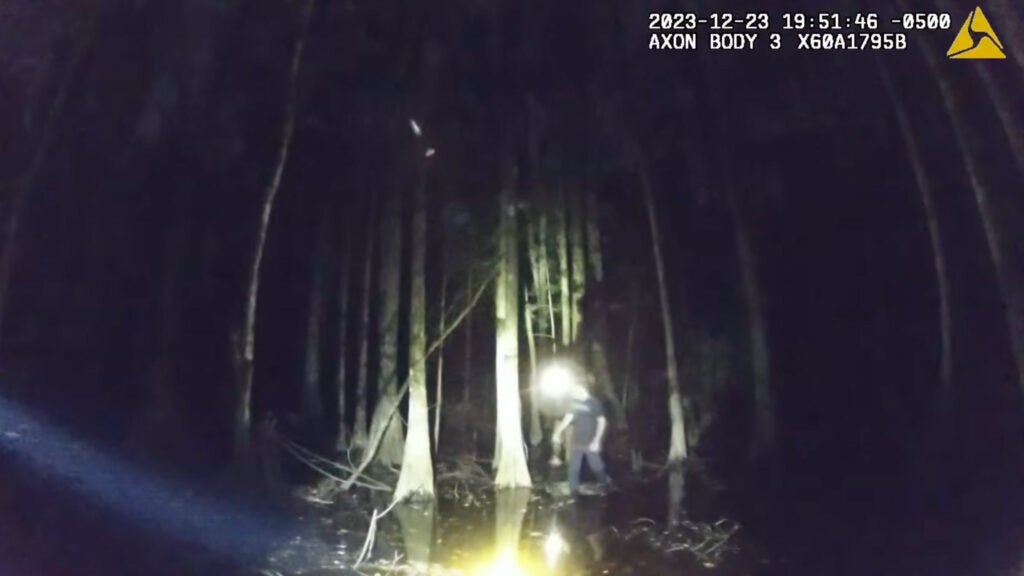



While other people planned holiday menus or enjoyed time off with their families on December 23, a pair of hikers in western Florida found themselves trudging through a dark swamp, lost, looking out for gators, and very much alone.
In a Facebook post, the Hillsborough County Sheriff’s Office (HCSO) said that it had received a call about two hikers who were unable to find their way back to the trailhead in Cypress Creek Preserve, an 11-square-mile natural area northeast of Tampa. Home, like many Florida hiking areas, to a population of alligators, Cypress Creek Preserve has 19 miles of hiking trails, which its site notes can flood during periods of high water.
The HCSO said it “sprang into action” upon receiving the report. The office sent out its aviation unit to search for the hikers from the air with night vision goggles and located the pair around 7:30 p.m. in a “swampy area.” The unit guided deputies to the lost hikers, who were unhurt; body camera footage showed the still-smiling pair trudging through a dense forest flooded to mid-shin, with only a cell phone to light the way. HCSO said deputies successfully guided the unidentified hikers back to the trailhead.
Sneaking a hike into your vacation is one of the best parts of the holidays, but no one wants to spend their Christmas wandering around the woods. Follow these tips to keep your next hike drama-free.
A soggy hike through the southern lowlands may not come with the same dangers as a blizzard in the mountains, but Florida trails have their own hazards, and it’s smart to respect them when you pack. Having a way to navigate likely would have helped both of these hikers make it home in time to catch A Charlie Brown Christmas on TV instead of calling in the cavalry. Using a hiking-specific app (cough cough Outside’s Gaia GPS) is an easy way to orient yourself even when the trail disappears under high waters, assuming you remember to download maps for the area you’re hiking in, carry extra power, and protect your electronics from moisture. (Navigating by map and compass is low-tech and reliable, but can be hard to do in low-visibility terrain like a dense and dark swamp.) Cell phone lights are too weak to be much use on the trail; carry a lightweight, rechargeable headlamp instead.
While hypothermia isn’t exactly a common cause of death among Florida hikers, the Sunshine State can get colder than you think: Overnight lows in the area this week are dipping into the mid-40s, which are potentially hazardous to the wet and underdressed. Consider tucking a light synthetic layer or a space blanket into your pack, even when the weather doesn’t seem to warrant it.
Several news stories about this month’s rescue described Cypress Creek as “alligator-infested.” While that’s a loaded way to phrase it, it’s true that the large reptiles are a common site along the area’s trails. Several trip reports mention sightings of gators in nearby creeks and swampland. Florida is home to an estimated 1.25 million alligators and sees an average of 8 unprovoked bites per year, so hikers hitting the trail anywhere in the state need to learn to be safe around the leathery critters.
The good news: Gators don’t go looking for trouble. By following a few simple guidelines, you can drastically lower your chances of a run-in. Don’t enter lakes, rivers, or swampland outside of designated swimming areas, be cautious when gathering drinking water, and avoid swimming or wading during dawn or dusk, when gators are more active. If you do encounter a gator, leave it plenty of space—at least 20 feet—and make plenty of noise to alert it to your presence and give it an opportunity to vacate the area. Unsure of whether it’s safe to hike that flooded trail? It never hurts to ask rangers or local hikers for the beta.
From 2023

